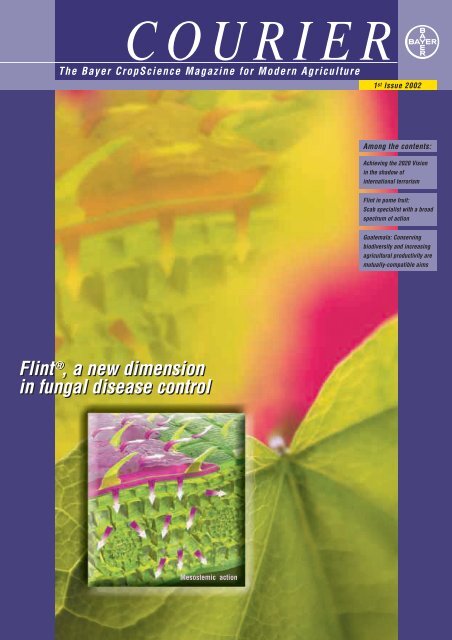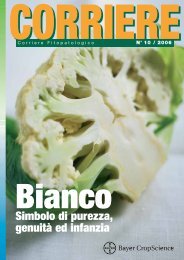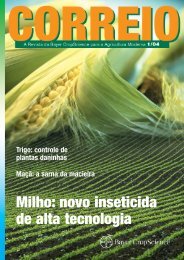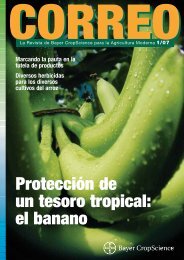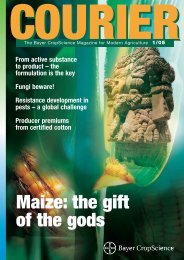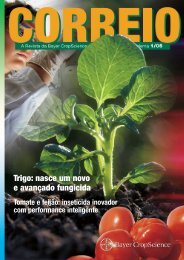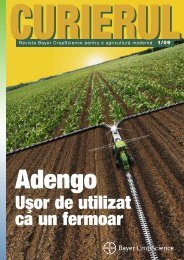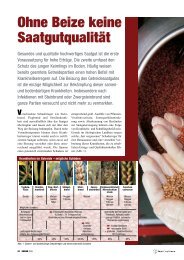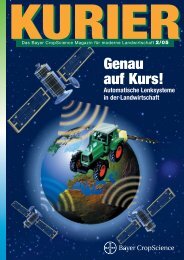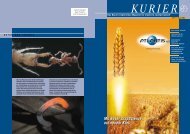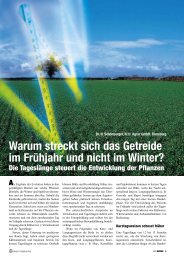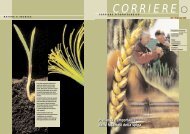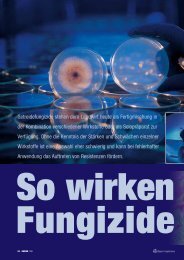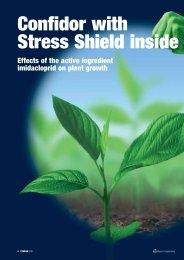Flint®, a new dimension in fungal disease control Flint®, a new ...
Flint®, a new dimension in fungal disease control Flint®, a new ...
Flint®, a new dimension in fungal disease control Flint®, a new ...
- No tags were found...
Create successful ePaper yourself
Turn your PDF publications into a flip-book with our unique Google optimized e-Paper software.
sta<strong>in</strong>able agriculture”Summit on Susta<strong>in</strong>able DevelopmentTechnology development and transferare critical processes for creat<strong>in</strong>gopportunities for susta<strong>in</strong>ableagriculture. One related Bayer casestudy mentioned <strong>in</strong>cludes thedevelopment of an <strong>in</strong>secticide tocombat corn pests for meet<strong>in</strong>gfarmers’ needs <strong>in</strong> South Africa.Develop<strong>in</strong>g <strong>control</strong>led-dosedelivery systems and appropriatepackag<strong>in</strong>g sizes for smallholderfarmers are other examples.Smallholder farmers’ needs <strong>in</strong>develop<strong>in</strong>g areas must be addressedto promote the goals of povertyalleviation and food securitythrough economic development.Examples <strong>in</strong>clude work <strong>in</strong> Kenyawith a local NGO to help identifyand develop pest <strong>control</strong> methodsfor pests and <strong>disease</strong>s of staple foodcrops, such as sorghum, beans andcowpeas, <strong>in</strong> order to improve yieldsand thus secure the food supply.Crop protection products play a keyrole <strong>in</strong> farmers’ efforts to protectand enhance the environment by<strong>in</strong>creas<strong>in</strong>g productivity from exist<strong>in</strong>gland rather than br<strong>in</strong>g<strong>in</strong>g <strong>new</strong>land <strong>in</strong>to agricultural production.Industry-stimulated studies provide<strong>in</strong>sight <strong>in</strong>to better plann<strong>in</strong>g andland management and build on thelong-stand<strong>in</strong>g <strong>in</strong>dustry commitmentto put susta<strong>in</strong>able agriculture <strong>in</strong>topractice by apply<strong>in</strong>g <strong>in</strong>tegrated cropmanagement (ICM) and <strong>in</strong>tegratedpest management (IPM) techniques.All of the case studies identifiedare examples of bus<strong>in</strong>ess activitiesand market approaches designedto meet the economic needs of all<strong>in</strong>volved. Creat<strong>in</strong>g market opportunitiesis the most susta<strong>in</strong>ableapproach to development, agricultureand bus<strong>in</strong>ess <strong>in</strong> the long run,because susta<strong>in</strong>ability is easiest toachieve when all stakeholdersbenefit. Industry has <strong>in</strong>frastructures<strong>in</strong> many countries, a lot of expertiseand knowledge, and often thestay<strong>in</strong>g power to br<strong>in</strong>g abouteconomic development – providedof course that the enabl<strong>in</strong>g framework,<strong>in</strong>clud<strong>in</strong>g good governanceand efficient market mechanisms,are <strong>in</strong> place to allow these efforts tosucceed.A susta<strong>in</strong>able bus<strong>in</strong>ess approachesencompasses more than just sell<strong>in</strong>gproducts: It provides technologypackages and services, knowledgeand expertise which ensure thatproducts are supplied along withproper support. In this context,capacity build<strong>in</strong>g - tra<strong>in</strong><strong>in</strong>g andeducation – plays an important role<strong>in</strong> our daily bus<strong>in</strong>ess at Bayer. Weare keen to contribute to susta<strong>in</strong>abledevelopment <strong>in</strong> our field ofexpertise and are committed toma<strong>in</strong>ta<strong>in</strong><strong>in</strong>g open l<strong>in</strong>es of communicationand to seek multi-stakeholderpartnerships. The latter arethe model for the future, becauseno s<strong>in</strong>gle group can either hold allof the <strong>in</strong>formation and skillsrequired or carry out all of thework. ■The publication “Creat<strong>in</strong>g Opportunitiesfor Susta<strong>in</strong>able Agriculture”can be obta<strong>in</strong>ed from:CropLife InternationalAvenue Louise 143B-1050 BrusselsBelgiumTel: +32 2 542 0410Fax: +32 2 542 041Email: <strong>in</strong>fo@croplife.orgIt can also be found on theCropLife International websitewww.croplife.org.“Let uschoose tounite thepower ofmarkets withthe authorityof universalideals. Let uschoose toreconcile thecreativeforces of private entrepreneurshipwith the needs of the disadvantagedand the requirements of futuregenerations.”Kofi Annan,Secretary-General of the United NationsBayer’s herbicides:Valuable tools <strong>in</strong> effectivecrop managementAchiev<strong>in</strong>g the 2020 Vision<strong>in</strong> the shadow of<strong>in</strong>ternational terrorismFl<strong>in</strong>t <strong>in</strong> pome fruit:Scab specialist with a broadspectrum of actionCourierOnl<strong>in</strong>e-News:www.agrocourier.com4Fl<strong>in</strong>t, a <strong>new</strong> <strong>dimension</strong><strong>in</strong> <strong>fungal</strong> <strong>disease</strong> <strong>control</strong>16Guatemala: Conserv<strong>in</strong>gbiodiversity and <strong>in</strong>creas<strong>in</strong>gagricultural productivity aremutually-compatible aimsPublished by: Bayer AG, Bayer CropScience,Monheim / Editors: Dr. Georg Priestel, BernhardGrupp, Kai Kellenberger / Responsible for contents:Dr. Georg Priestel / With contributions from: A.Dollacker, U. Mohan, Ng Kwang Yew, Dr. H. Santel,Dr. A. Witzenberger / Design and production:Bernhard Grupp / Layout: Xpertise, Langenfeld /Litography: Brockhaus & Conrad, Sol<strong>in</strong>gen /Pr<strong>in</strong>ted by: Broermann, Troisdorf / Reproduction ofcontents is permissible provid<strong>in</strong>g Bayer is acknowledgedand advised by specimen copy / Editor’saddress: Bayer AG, BayerCropScience, PM-Market<strong>in</strong>gServices, Alfred-Nobel-Straße 50, D-40789Monheim, Germany, FAX: 0049-2173-383133 /Website: www.bayercropscience.com81220CONTENTSCourier 1/2002
Valuacrop
le tools <strong>in</strong>effectivemanagementAn <strong>in</strong>troduction to Bayer’s herbicidesBayer has long been known<strong>in</strong> agriculture circles for itscrop protection products.In the past, its particular strengthshave been fungicides and <strong>in</strong>secticides.Bayleton ® , Bayfidan ® , Folicur® and the recently launchedFl<strong>in</strong>t ® are brands that have demonstratedBayer's expertise <strong>in</strong> <strong>control</strong>l<strong>in</strong>g<strong>fungal</strong> <strong>disease</strong>s. The active<strong>in</strong>gredients conta<strong>in</strong>ed <strong>in</strong> these productsare triadimefon, triadimenol,tebuconazole and trifloxystrob<strong>in</strong>,respectively.Bayer's strong position <strong>in</strong> the<strong>in</strong>secticides field started with thedevelopment of phosphoric acidesters such as E 605 ® and Metasystox® R. Beta-cyfluthr<strong>in</strong>, thepyrethroid that is the active substance<strong>in</strong> Bulldock ® , is the answerto a wide range of problems affect<strong>in</strong>gmany crops, and is effective atrelatively low rates. Imidacloprid,sold as Gaucho ® and Confidor ® , istoday the world's top-sell<strong>in</strong>g <strong>in</strong>secticide,registered <strong>in</strong> more than 120countries for use <strong>in</strong> over 140 crops.It is often forgotten that Bayer alsooffers a respectable range of versatileherbicide products, based ontwelve different active substancesthat work <strong>in</strong> four different ways.The history of Bayer's herbicides<strong>in</strong>cludes successful brands likeGoltix ® and Sencor ® along withsome more recent <strong>in</strong>troductions.The <strong>new</strong>er arrivals <strong>in</strong>clude herbicidesconta<strong>in</strong><strong>in</strong>g the <strong>new</strong> active substanceflufenacet, alongside Mikado ® ,Attribut ® and Everest ® . This articledescribes just what Bayer has tooffer.Sencor – a well-establishedproduct with a promis<strong>in</strong>gfutureMetribuz<strong>in</strong>, the active substance <strong>in</strong>Sencor, belongs to the triaz<strong>in</strong>onesgroup of chemicals and works by<strong>in</strong>hibit<strong>in</strong>g photosynthesis. It isabsorbed via the soil and throughthe leaves, so it can be used bothbefore and after weed emergence.When Sencor was launched <strong>in</strong> the1970s, it revolutionised weed<strong>control</strong> <strong>in</strong> soya bean crops. Thiswell-proven basic herbicide is nowregistered <strong>in</strong> 101 countries for use <strong>in</strong>76 different crops, <strong>in</strong>clud<strong>in</strong>g potato,soya bean, vegetables and sugarcane.One of the ma<strong>in</strong> advantages ofSencor is its versatility, whether it isused alone or as part of a multiproductspray<strong>in</strong>g programme. Fromthis po<strong>in</strong>t of view, it is superior tomany rival products. Its widespectrum of action aga<strong>in</strong>st broadleavedand grass weeds and its suitabilityfor use together with otherproducts are qualities that farmerscont<strong>in</strong>ue to appreciate. Producedand used with the know-how thatBayer has built up over the years,Sencor offers users consistently highquality.Goltix – two decadesof outstand<strong>in</strong>g safetyand qualityFor more than 20 years, Goltix hasbeen one of Bayer's most successfulproducts. Used ma<strong>in</strong>ly <strong>in</strong> sugar beetbut also <strong>in</strong> soft fruit, Goltix hasbecome the standard product for<strong>control</strong>l<strong>in</strong>g black nightshade, commonchickweed, goosefoot,camomile, violets and annual bluegrass.Goltix conta<strong>in</strong>s metamitron,another member of the triaz<strong>in</strong>onefamily. It also acts via the soil andthrough the leaves and can be usedboth before and after emergence.The Goltix 700 SC and Goltix 70WG formulations have proved themost commercially popular.However, the example of Goltixshows clearly that even tried andtested commercial products can befurther improved. Us<strong>in</strong>g modernformulation techniques, Bayer hasbeen able to make Goltix evenmore effective. The <strong>new</strong> formulation,Goltix 90 WG, has alreadybeen registered and launched <strong>in</strong>several European countries. Thema<strong>in</strong> advantages are its concentratedaction and ease of use. It ispresented <strong>in</strong> an <strong>in</strong>novative granularform, allow<strong>in</strong>g for dust-free andtherefore safer and more economicalapplication.This <strong>new</strong> development can besummed up as follows: More active<strong>in</strong>gredient. More surface area. Moresugar beet.“Power by FOE”Flufenacet (FOE 5043) belongs tothe oxyacetamide group of chemicals.This substance was first synthesised<strong>in</strong> 1988, and after a decade ofcomprehensive test<strong>in</strong>g, the firstcommercial product was launched<strong>in</strong> 1998. Flufenacet has a broadspectrum of action. It effectively<strong>control</strong>s important grass weeds,<strong>in</strong>clud<strong>in</strong>g various species of millet.It also has a considerable secondaryeffect on dicotyledenous weeds suchas cleavers (catchweed). Anotheradvantage of flufenacet is that it canbe applied to a wide range of crops,Courier 1/20025
Valuable tools <strong>in</strong>such as maize, soya bean, potato,cereals, rice and peanut. Flufenacetis absorbed ma<strong>in</strong>ly through theroots, or by the <strong>new</strong>ly sproutedseed, <strong>in</strong>hibit<strong>in</strong>g cell division <strong>in</strong> theseparts of the plant. This stops theweed from extend<strong>in</strong>g, and theplants either fail to emerge or donot develop further.Flufenacet is an ideal partner foruse <strong>in</strong> comb<strong>in</strong>ation with otheractive substances, so that the specialneeds of <strong>in</strong>dividual crops can beproperly met. Artist ® , Axiom ® ,Epic ® , Doma<strong>in</strong> ® , Drago ® , Herold ®and Terano ® are the brands conta<strong>in</strong><strong>in</strong>gflufenacet. The table oppositeshows how the various comb<strong>in</strong>ationsare used.The two youngsters:Attribut and EverestIn the early 1990s, Bayer discovereda <strong>new</strong> class of molecules that act <strong>in</strong>a <strong>new</strong> way to effectively <strong>control</strong>grass weeds and broad-leavedweeds. Flucarbazone-sodium andpropoxycarbazone-sodium aremembers of the sulphonylam<strong>in</strong>ocarbonyl triazol<strong>in</strong>ones groupand <strong>in</strong>hibit acetolactate synthase(ALS <strong>in</strong>hibitors).Flucarbazone-sodium was successfullylaunched under the tradename Everest® <strong>in</strong> North America<strong>in</strong> spr<strong>in</strong>g 2000. The product offerswheat growers a simple, environmentallyacceptable and economicalsolution to problem weed grasses.The two grass weeds that are hardestto <strong>control</strong> <strong>in</strong> summer wheatcrops are wild oats (Avena fatua)and green foxtail (Setaria viridis).These two weeds entered NorthAmerica <strong>in</strong> contam<strong>in</strong>ated seed shipmentsand have been giv<strong>in</strong>g cerealfarmers a headache for over acentury. They cause serious yieldlosses because they can competestrongly with the crop.Thanks to its novel mechanism ofaction, <strong>in</strong>clud<strong>in</strong>g uptake throughleaves and soil, flucarbazonesodiumcan be applied much earlierthan active substances used <strong>in</strong> thepast. This means that weed grassescan be <strong>control</strong>led before they startto compete with the crop.Flucarbazone-sodium also broke<strong>new</strong> ground <strong>in</strong> reduc<strong>in</strong>g applicationrates and the risk to the user associatedwith application. Just 30 g ofactive substance per ha is enough toachieve effective <strong>control</strong>. Theproduct is packed <strong>in</strong> water-solublebags which are easy for users tohandle and elim<strong>in</strong>ate time-consum<strong>in</strong>gmeasur<strong>in</strong>g out.Everest has now been successfully<strong>in</strong>troduced <strong>in</strong> Canada, the UnitedStates, Kazakhstan and Chile. Inthe future, farmers <strong>in</strong> the MiddleEast, Turkey, Russia and Ch<strong>in</strong>a willalso be able to enjoy the benefits ofEverest.Propoxycarbazone-sodium (productname: Attribut ® ) is the latest herbicidalactive substance to emergefrom Bayer's research pipel<strong>in</strong>e. It isa selective herbicide which <strong>control</strong>sseveral important grass and broadleavedweeds after they emerge <strong>in</strong>wheat, w<strong>in</strong>ter rye and triticale.Propoxycarbazone-sodium isabsorbed through the leaves androots and is then distributed systemicallythroughout the plant. Susceptibleplants stop grow<strong>in</strong>g shortlyafter treatment. The herbicidalaction normally lasts for up to fourweeks, which is long enough to killweed grasses, <strong>in</strong>clud<strong>in</strong>g those thatgerm<strong>in</strong>ate after application. Thespeed of action depends on environmentalconditions, and <strong>in</strong>creaseswhen the temperature and soilhumidity are high.Otherwise the spectrum of action<strong>in</strong>cludes black-grass (Alopecurusmyosuroides), loose silky-bent(Apera spica-venti) and the hardto-<strong>control</strong>brome grasses. The substanceis also successful <strong>in</strong> <strong>control</strong>l<strong>in</strong>gcouchgrass (Agropyron repens),a perennial weed grass <strong>in</strong> which itacts systemically to kill off theunderground rhizomes. Propoxycarbazone-sodiumalso <strong>control</strong>ssome broad-leaved weeds, particularlyspecies of the crucifer family(Brassicaceae).The substance can be used either onits own or <strong>in</strong> a tank mix with otherherbicides with a complementaryspectrum of action aga<strong>in</strong>st broadleavedweeds.6Courier 1/2002
effective crop managementAttribut was developed for thecereals markets <strong>in</strong> all the majorEuropean countries and Kenya,Mexico and the United States.New acquisitions:Mikado and metosulamBayer's herbicide portfolio has beenboosted by the arrival of the <strong>new</strong>acquisitions Mikado ® and metosulam.Mikado enables Bayer to offera popular herbicide for earlypost-emergence application that can<strong>control</strong> important weeds affect<strong>in</strong>gEuropean maize crops.Metosulam is a versatile substance,with applications <strong>in</strong> a range of crops<strong>in</strong>clud<strong>in</strong>g cereals, maize, potato,lup<strong>in</strong>, lawn grass, meadow grass,and sugar beet. Metosulam is anideal partner for many other active<strong>in</strong>gredients.A chapter to themselves:rice herbicidesPropanil had been used successfully<strong>in</strong> rice for many years; the nextmajor step forward was taken <strong>in</strong> themid-1980s when mefenacet (tradenames H<strong>in</strong>ochloa ® , Rancho ® ) was<strong>in</strong>troduced as a one-shot herbicideto <strong>control</strong> weeds. One-pass weed<strong>control</strong> <strong>in</strong> the rice paddy becamepossible with the application ofmefenacet <strong>in</strong> comb<strong>in</strong>ation with abroadleaf herbicide. Designedespecially for rice, this substance is,like flufenacet, a member of theoxyacetamide class discovered byBayer <strong>in</strong> 1974. In the most importantmarket, Japan, H<strong>in</strong>ochloa wasseen as the most important herbicide<strong>in</strong> that segment for many years.The active substance fentrazamideis now sett<strong>in</strong>g <strong>new</strong> standards <strong>in</strong> ricecultivation. It was developed atBayer's research centre <strong>in</strong> Yuki,Japan, and <strong>in</strong>troduced <strong>in</strong> the majorrice-grow<strong>in</strong>g countries <strong>in</strong> 2000/2001,for example <strong>in</strong> Japan, under thetrade name Innova ® . As it has anoutstand<strong>in</strong>g and long-last<strong>in</strong>g effecton barnyardgrass (Ech<strong>in</strong>ochloacrus-galli), it is the ideal choice foruse <strong>in</strong> transplanted rice. The herbicideis applied as the seedl<strong>in</strong>gs aretransplanted from the seed boxes toAt a glance: The Bayer herbicidestheir f<strong>in</strong>al grow<strong>in</strong>g position <strong>in</strong> thepaddy and <strong>control</strong>s weeds throughoutthe entire season. This saveswork, time and money. No otherherbicide enables farmers to comb<strong>in</strong>eplant<strong>in</strong>g out with herbicideapplication. Synchronis<strong>in</strong>g thesetwo processes represents an importanttechnological <strong>in</strong>novation thatBayer has realised for rice growers.But fentrazamide can also be used<strong>in</strong> directly sown rice. The comb<strong>in</strong>ationproduct Lecspro ® (6.75%fentrazamide and 37.5% propanil)is the flexible alternative, conta<strong>in</strong><strong>in</strong>gboth the old and the <strong>new</strong> substancefor <strong>control</strong>l<strong>in</strong>g Ech<strong>in</strong>ochloacrus-galli, various sedges and broadleavedweeds.These examples show how muchBayer is do<strong>in</strong>g to f<strong>in</strong>d the rightsolutions to weed problems. Ourtop priority is still the same: to helpfarmers obta<strong>in</strong> the highest possibleyields from the crops they grow.This is how Bayer's herbicides canmake a significant contribution tothe farmer’s economic success. ■Active substance Trade name CropsFlufenacet Axiom ® Soya beanTerano ® MaizeHerold ® CerealsArtist ® PotatoMetamitron Goltix ® Sugar beetMetribuz<strong>in</strong> Sencor ® Soya bean,potato, tomato,cereals, sugar beetMefenacet H<strong>in</strong>ochloa ® RiceFentrazamide Innova ® RiceLecspro ®Flucarbazone-sodium Everest ® Wheat,Durum wheatPropoxycarbazone- Attribut ® Cerealssodium Olympus ®Metosulam Eclipse ® Maize, cerealsSulcotr<strong>in</strong>e Mikado ® MaizeCourier 1/20027
Achiev<strong>in</strong>g the 2020<strong>in</strong> the shadow of <strong>in</strong>ternational terrorism2001 World Food Prize Laureate Address*Good primary education for children isone of the most important <strong>in</strong>vestmentsfor the future.The brutal terrorist attack onSeptember 11 calls for twoparallel campaigns. First isthe ongo<strong>in</strong>g effort to identify anderadicate organizations that sponsor<strong>in</strong>ternational terrorism. Second is acampaign to elim<strong>in</strong>ate poverty,hunger, malnutrition, and mismanagementof natural resources—sourcesof extreme human misery thatfanatics use to justify their actions.IFPRI’s 2020 Vision Initiative is astep <strong>in</strong> that direction. It seeks aworld free of poverty, hunger, andmalnutrition, where naturalresources are managed susta<strong>in</strong>ably.8Courier 1/2002
VisionPer P<strong>in</strong>strup-Andersen**Primitive water supplies: sadly still thereality <strong>in</strong> many develop<strong>in</strong>g countries.Can we reach this goal by 2020?Yes, we can make it happen if weset the right priorities.A few statistics. The <strong>in</strong>comes of therichest 1 percent of the world'spopulation are equivalent to the<strong>in</strong>comes of the poorest 57 percent.And the relative <strong>in</strong>come distributionis gett<strong>in</strong>g worse. In 1960, theaverage per capita <strong>in</strong>come <strong>in</strong> <strong>in</strong>dustrializednations was about 9 timesthat <strong>in</strong> Sub-Saharan Africa; today itis 18 times greater.Twenty percent of the world's population— about 1.2 billion people —live on less than US$1 a day. And800 million people are “food <strong>in</strong>secure”;they go to bed hungry. Everyyear 5–7 million children die fromnutrition-related illnesses. I wouldargue that no society, national or<strong>in</strong>ternational, can be stable whensuch <strong>in</strong>equalities and widespreadhuman suffer<strong>in</strong>g exist.What about the future? FAO’s mostlikely scenario projects that we willreduce the number of food-<strong>in</strong>securepeople from 800 to 600 million by2015. IFPRI projects that thenumber of malnourished childrenwill probably decrease from thecurrent 166 million to about 135million. Such slow progress is adisgrace.But there are viable alternatives.One scenario for br<strong>in</strong>g<strong>in</strong>g thesenumbers down faster f<strong>in</strong>ds that ifdevelop<strong>in</strong>g countries <strong>in</strong>creased<strong>in</strong>vestments by 40 percent <strong>in</strong> fivesectors — agricultural research,clean dr<strong>in</strong>k<strong>in</strong>g water, primary education,rural roads, and irrigation —the number of malnourished childrencould be reduced to about 90 million.The annual <strong>in</strong>vestment neededto achieve that number correspondsto less than 5 percent of the publicexpenditures <strong>in</strong> develop<strong>in</strong>g countries<strong>in</strong> 1997. That does not seem to bean excessive price to pay to havewell-nourished children. That’s o<strong>new</strong>eek of global military expenditures(before Afghanistan).The actions required to atta<strong>in</strong> the2020 Vision will have to be implemented<strong>in</strong> the context of emerg<strong>in</strong>gforces or trends. First, globalizationand trade liberalization. Globalizationis like a knife: it can be used toslice bread or to kill. Argu<strong>in</strong>g aboutwhether it is good or bad is notconstructive. Instead we should askhow we can make globalizationbeneficial for poor people.Develop<strong>in</strong>g countries should adoptpolicies to enable agriculture andother sectors to compete <strong>in</strong> a freemarketeconomy, while we <strong>in</strong> the<strong>in</strong>dustrialized countries need toopen up our markets to the productsthat develop<strong>in</strong>g countries canproduce competitively. I grew up ona farm, and I know it can be extremelydifficult to adjust to <strong>new</strong> pricesignals <strong>in</strong> the market. Can agriculturalsubsidies <strong>in</strong> Europe and the UnitedStates be changed so that theydo not damage develop<strong>in</strong>g countriesor excessively harm our own agriculture?We also must not make demands onimported food commodities thatdevelop<strong>in</strong>g countries cannot meetby us<strong>in</strong>g food safety regulationsto keep commodities out of ourmarkets, for example. We have“escalat<strong>in</strong>g tariffs”: the more adevelop<strong>in</strong>g country processes itsagricultural commodities, the higheris the rate of import duty. We helpdevelop<strong>in</strong>g countries improve theirprocess<strong>in</strong>g <strong>in</strong>dustries <strong>in</strong> rural areasto generate employment and addvalue to agricultural commodities.Then we turn around and say, “Butif you dare send your products toour countries, we are go<strong>in</strong>g to slap ahigh import tariff on them.” Wehave to be serious about level<strong>in</strong>gthe play<strong>in</strong>g field.* This is a shortened version of a speech given<strong>in</strong> Des Mo<strong>in</strong>es, Iowa, U.S., October 19, 2001** Director general of the International FoodPolicy Research Institute (IFPRI), 2033 KStreet, N.W., Wash<strong>in</strong>gton, D.C., 20006-1002,U.S.A. • tel. (202) 862-5600 • fax. (202) 467-4439 • email: IFPRI@cgiar.org • web:www.ifpri.org.Courier 1/20029
Irrigation systems like this spr<strong>in</strong>klercould make a significant contributionto modernis<strong>in</strong>g agriculture.Another concern stemm<strong>in</strong>g from<strong>in</strong>ternational terrorism: What ifpeople <strong>in</strong> the <strong>in</strong>dustrializedcountries say “it is too risky toimport food from develop<strong>in</strong>gcountries because it may have beentampered with,” or other countriessay “we do not want to importanyth<strong>in</strong>g from the United States, <strong>in</strong>case terrorists have tampered withit”? If the current <strong>in</strong>ternationalclimate pushes people toward selfsufficiency<strong>in</strong> food, the economicloss will be tremendous.The modern biological sciences and<strong>in</strong>formation and communicationstechnologies have much to offerpoor people <strong>in</strong> develop<strong>in</strong>g countries.But the benefits are notmaterializ<strong>in</strong>g because most of theresearch is focused on solv<strong>in</strong>g theproblems of <strong>in</strong>dustrialized countries.Very little available biotechcan be used by small farmers <strong>in</strong>develop<strong>in</strong>g countries.One reason the research is notbe<strong>in</strong>g done is the strong Europeanopposition to the use of geneticeng<strong>in</strong>eer<strong>in</strong>g <strong>in</strong> food. People <strong>in</strong> the<strong>in</strong>dustrialized countries can dowithout it. They eat quite well. Butdevelop<strong>in</strong>g countries do need it, andwe must not tell them that becausewe do not want it or need it, theycannot have it either.It has been said that those who sufferthe consequences of a decisionshould have a voice <strong>in</strong> mak<strong>in</strong>g it. AWest African farmer with six childrento feed often loses her corn cropto drought. She wants to plant agenetically eng<strong>in</strong>eered, droughttolerantcorn variety. Many wouldtell her to f<strong>in</strong>d another way. Whilewe figure out what that is, the childrensuffer.Another emerg<strong>in</strong>g force is therapidly worsen<strong>in</strong>g health crisis. The<strong>in</strong>teractions between HIV/AIDSand food <strong>in</strong>security are important.Those of us who focus on the foodside of the equation cannot ignorethe HIV/AIDS crisis <strong>in</strong> Africa.Many other health issues such asthe <strong>in</strong>crease <strong>in</strong> malaria and tuberculosisl<strong>in</strong>k to food security. Thel<strong>in</strong>k between conflict and food securityis also close at local, national,and <strong>in</strong>ternational levels.A few words about chang<strong>in</strong>g structures.On average, the South Asianfarmer has less than a football fieldof land on which to grow crops. Willsuch small farms be viable by 2020?Probably not. IFPRI is tak<strong>in</strong>g aclose look at what the most desirablefarm<strong>in</strong>g structure will be <strong>in</strong> 20years. At this po<strong>in</strong>t I can only saythat the def<strong>in</strong>ition of a small farm islikely to change dramatically.Another structural change has todo with consumption. We are <strong>in</strong> themiddle of a livestock revolution.There is go<strong>in</strong>g to be a sharp <strong>in</strong>crease<strong>in</strong> the demand for livestock commoditiesover the next 20 years,particularly <strong>in</strong> rapidly grow<strong>in</strong>gAsian countries. There will also bea steady <strong>in</strong>crease <strong>in</strong> the demand forprocessed and sugary foods.Regard<strong>in</strong>g chang<strong>in</strong>g roles andresponsibilities, governments <strong>in</strong>many countries used to have amonopoly on agricultural <strong>in</strong>putand output markets. A farmerwho wanted to buy fertilizer had togo to a parastatal. The governmentdecided how much fertilizer wouldcome <strong>in</strong>, what the price would be,and when it would be delivered.Today the parastatals have beenreplaced by the private sector. Butwe cannot expect the private sectorto produce goods and services theycannot make money on. Therefore,the government still has a role.Those who said “Less governmentis necessarily better government”turned out to be wrong. We needstrong governments to do the k<strong>in</strong>dsof th<strong>in</strong>gs only they can do, such asprovid<strong>in</strong>g primary education, basichealth care, agricultural research,All must have access to clean dr<strong>in</strong>k<strong>in</strong>gwater.10Courier 1/2002
Genetically improved crops offer anopportunity to small-scale farmers <strong>in</strong>develop<strong>in</strong>g countries too.and <strong>in</strong>frastructure. We needstandards, measurements, andenforcement of contracts.Markets may not be reformedunless the government does it.But market reforms <strong>in</strong> Africa havenot worked to the extent that wehad hoped. In some cases, privatemonopolies have replaced statemonopolies; <strong>in</strong> other cases, poorpeople <strong>in</strong> remote areas are notbe<strong>in</strong>g served.A grow<strong>in</strong>g share of agriculturalresearch is carried out by theprivate sector and subject topatents, so it may not benefit poorpeople <strong>in</strong> develop<strong>in</strong>g countries.Public and nonprofit agenciesshould expand research orientedtoward poor people. Determ<strong>in</strong><strong>in</strong>gwhat the private sector, the government,and the NGOs each do best isthe issue.One reason why we still have somany hungry people is the lack ofpolitical will. Governments <strong>in</strong> manydevelop<strong>in</strong>g countries really do notput high priority on eradicat<strong>in</strong>gpoverty, hunger, and child malnutrition.And as long as they donot, development assistance will nothave much of an impact. We needbetter governance and less corruption.My last po<strong>in</strong>t on chang<strong>in</strong>g responsibilitieshas to do with the role of<strong>in</strong>dustrialized countries. We need toseek more not less engagement <strong>in</strong>the <strong>in</strong>ternational community. Onepotential risk associated with theterrorists' attack is the tendency tobuild taller walls. That would be agrave mistake. The United States isalready at the bottom of the list of<strong>in</strong>dustrialized countries when itcomes to development assistance,giv<strong>in</strong>g less than one-tenth of 1 percentof its national <strong>in</strong>come.F<strong>in</strong>ally, we <strong>in</strong> the high-<strong>in</strong>come partof the world have a choice. We canspend <strong>in</strong>creas<strong>in</strong>g amounts of moneyto protect ourselves, or we canspend the same amount of moneyon remov<strong>in</strong>g the root causes of<strong>in</strong>ternational terrorism and other<strong>in</strong>stabilities. Unless we correct the<strong>in</strong>justices that the fanatics cite as areason for attack<strong>in</strong>g us, we willcont<strong>in</strong>ue to live under a cloud offear. ■Intensive research by companies andpublic bodies has long formed a solidbasis for susta<strong>in</strong>able agriculture.Let it not just rema<strong>in</strong> a dream: enoughgood-quality food for all the world.Courier 1/200211
Fl<strong>in</strong>t <strong>in</strong> pome fruit:Scab specialistspectrum ofPome-fruit growers all over theworld look<strong>in</strong>g for a powerfulfungicide to combat scab<strong>disease</strong>s (Venturia spp.) are <strong>in</strong>creas<strong>in</strong>glyturn<strong>in</strong>g to a product <strong>in</strong> Bayer'sportfolio – the mesostemic fungicideFl<strong>in</strong>t® 50 WG. Its outstand<strong>in</strong>g performanceaga<strong>in</strong>st fruit and leaf scabsets <strong>new</strong> standards <strong>in</strong> the <strong>control</strong> ofthese <strong>disease</strong>s, which are by far themost serious affect<strong>in</strong>g pome fruit.Fl<strong>in</strong>t <strong>control</strong>s a large number ofpome fruit <strong>disease</strong>s when appliedpreventively. These <strong>in</strong>clude powderymildew (Podosphaera leucotricha)and other important <strong>disease</strong>s affect<strong>in</strong>gfruits<strong>in</strong> the summer season and dur<strong>in</strong>gstorage. It offers growers a safe andreliable way of maximis<strong>in</strong>g both yieldand fruit quality. But Fl<strong>in</strong>t has manyother positive qualities:• Formulated as extruded granules,the product is presented <strong>in</strong> a modern,easy-to-handle formulation.• Plant tolerance is high, allow<strong>in</strong>gflexible use <strong>in</strong> spray<strong>in</strong>g programmesthroughout the entire grow<strong>in</strong>gperiod.• Fl<strong>in</strong>t is highly resistant to ra<strong>in</strong> andhas a long residual action.• Its favourable toxicological profileand low residue levels make it safefor users, pickers and consumers.• Fl<strong>in</strong>t is ideal for use <strong>in</strong> <strong>in</strong>tegratedproduction systems because it isunlikely to harm beneficial organisms.• Through its reasonable price, lowdosage and positive impact on yieldand quality, Fl<strong>in</strong>t makes a majorcontribution to boost<strong>in</strong>g the net<strong>in</strong>comes of pome fruit growers.Mesostemic action – whatdoes that mean?Fl<strong>in</strong>t conta<strong>in</strong>s the active <strong>in</strong>gredienttrifloxystrob<strong>in</strong>, a second-generationstrobilur<strong>in</strong> that, like all substances<strong>in</strong> the <strong>in</strong>novative strobilur<strong>in</strong> fungicidesgroup, is derived from theFl<strong>in</strong>t – Mesostemic ActionCharacteristics of Mesostemic Systemic Loco-systemic Contactactive substance (trifloxystrob<strong>in</strong>) (triazoles) (e.g. cymoxanil) (e.g. mancozeb)Active on the ● ●plant surfaceAbsorption by thewaxy layerSuperficial vapourmovement andre-depositionPenetration <strong>in</strong>to ● ●plant tissuesTranslam<strong>in</strong>ar ● ●movementTransport <strong>in</strong> the●vascular system12Courier 1/2002
with a broadactionnaturally-occurr<strong>in</strong>g substancesstrobilur<strong>in</strong> A and oudemans<strong>in</strong> A.These two substances are extremelysensitive to light and therefore havetoo short a half-life to be used <strong>in</strong>practice as fungicides.In the case of trifloxystrob<strong>in</strong>, theactive group <strong>in</strong> the molecule – thetriene system – has been stabilisedby chang<strong>in</strong>g the molecular structureto <strong>in</strong>clude a phenyl r<strong>in</strong>g and atrifluoromethyl side cha<strong>in</strong>. This sidecha<strong>in</strong> also gives Fl<strong>in</strong>t the unique“mesostemic” properties thatdist<strong>in</strong>guish it from other fungicidalsubstances. Its strong aff<strong>in</strong>ity to waxmakes the substance stick to theupper surfaces of plants for a longtime, form<strong>in</strong>g a ra<strong>in</strong>-resistantdeport of the active <strong>in</strong>gredient. Wellprotected aga<strong>in</strong>st the elements,trifloxystrob<strong>in</strong> can now exert itspowerful and last<strong>in</strong>g <strong>in</strong>fluence.Fl<strong>in</strong>t – Outstand<strong>in</strong>g activity aga<strong>in</strong>st apple scap due to its <strong>in</strong>hibitoryeffects at multiple stages <strong>in</strong> the life cycle of Venturia <strong>in</strong>aequalisRedistribution mechanisms alsohelp it to reach nearby areas thatwere not directly reached by thespray. For <strong>in</strong>stance, the substancediffuses <strong>in</strong>to the leaf tissue, fromwhere it exerts its translam<strong>in</strong>araction. Smaller but still biologicallyeffective amounts evaporate andare transported to other parts of thetreated plant. This means that theprotective fungicidal coat<strong>in</strong>g thatsurrounds the plant and effectivelywards off <strong>fungal</strong> <strong>in</strong>fections isreplenished from the depot.Top-level scab <strong>control</strong>Scab <strong>disease</strong>s are by far the mostserious affect<strong>in</strong>g pome fruit. Scabson apples or pears decrease boththe quality and the quantity of theharvest. As scab <strong>in</strong>fections affect allthe non-woody parts of the tree, therepeated leaf loss they cause canimpair the tree's ability to grow andproduce fruit, and can even, <strong>in</strong>extreme cases, eventually kill trees.Scab fungi are extremely fertile,often produc<strong>in</strong>g over 10 generationsReleased ascospores✗Ascospore onleaf surface✗Germ<strong>in</strong>ation andpenetration by ascosporePseudothecium conta<strong>in</strong><strong>in</strong>gasci and ascosporesGerm<strong>in</strong>ation andpenetration by conidium✗Overw<strong>in</strong>ter<strong>in</strong>gConidiumInfected leaveson groundConidiaConidiophoresStroma withsporulation✗Growth of subcuticularmycelium and stromaConidia onleaf surfaceGerm<strong>in</strong>at<strong>in</strong>gconidiumConidia onconidiophoresYoung stromaCourier 1/200213
of spores a year, and the risk of<strong>in</strong>fection is present right from thestart of the grow<strong>in</strong>g period (“greentips” stage) through to the end ofthe season. It should thereforecome as no surprise to learn that <strong>in</strong>the year 2000, around US$150 millionwas spent worldwide on fungicidesfor use <strong>in</strong> spray<strong>in</strong>g programmesto <strong>control</strong> scab.Growers already have a choice ofseveral fungicides to combat scab<strong>disease</strong>s. But Fl<strong>in</strong>t, Bayer's <strong>new</strong>high-performance fungicide, sets<strong>new</strong> standards. Several comparativefield trials, some of which were conductedby <strong>in</strong>dependent researchers,found that Fl<strong>in</strong>t was clearly worthyof its lead<strong>in</strong>g position. Initial experience<strong>in</strong> practice has emphaticallyconfirmed this. Producers of highqualityfruit, especially <strong>in</strong> areasvulnerable to scab, will therefore bedelighted to have access to this <strong>new</strong>fungicide.Fl<strong>in</strong>t normally <strong>in</strong>hibits the earlystages of <strong>fungal</strong> pathogen development,particularly spore germ<strong>in</strong>ationand germ-tube growth. For thisreason, it is best applied early as aprophylactic treatment. However,apple scab is slightly different <strong>in</strong>that the powerful <strong>in</strong>tr<strong>in</strong>sic action ofFl<strong>in</strong>t enables it to <strong>control</strong> laterstages of the fungus (such as thegrowth of the subcuticular stroma)as well. This offers added flexibility<strong>in</strong> spray<strong>in</strong>g programmes designed toFl<strong>in</strong>t – Spectrum of Efficacy●●●● = excellent ●●● = good ●● = moderate ● = poorcombat this <strong>disease</strong>.In view of its excellent potentialefficacy, Fl<strong>in</strong>t is normally <strong>in</strong>cluded<strong>in</strong> anti-scab spray<strong>in</strong>g programmeswhen weather conditions arefavourable to <strong>fungal</strong> reproductionand the <strong>in</strong>fection pressure isstrongest. This can occur dur<strong>in</strong>g thepre-blossom stage, but <strong>in</strong> mostyears, the pr<strong>in</strong>cipal <strong>in</strong>fection periodco<strong>in</strong>cides with the time when pomefruit trees are <strong>in</strong> bloom. Mistakes <strong>in</strong>scab <strong>control</strong> dur<strong>in</strong>g this phase cannotbe subsequently corrected. Thisis why the fungicidal treatment used<strong>in</strong> spr<strong>in</strong>g is so important to successful<strong>disease</strong> <strong>control</strong>.Fl<strong>in</strong>t is most effective aga<strong>in</strong>st scabwhen used preventively. Applicationrate recommendations varyfrom country to country, depend<strong>in</strong>gon the local conditions, and rangefrom 7.5–15 g product/100 l 1 . The<strong>in</strong>terval between applicationsshould not exceed 10 days whenspray<strong>in</strong>g Fl<strong>in</strong>t dur<strong>in</strong>g the pr<strong>in</strong>cipal<strong>in</strong>fection period or <strong>in</strong> orchards withstrong shoot growth. Intervals maybe extended to 10–12 days when theproduct is used later, or <strong>in</strong> generalwhen the risk of <strong>in</strong>fection is lower.Multi-talented and versatileOne of the greatest strengths ofFl<strong>in</strong>t is that it <strong>control</strong>s or at leastsuppresses many other important<strong>disease</strong>s of pome fruit alongsidescab; the level of success dependson the application volume used.For example, the application ratesPathosystem / DisorderActivitypreventive curativeVenturia spp. (scap on apple and pear) ●●●● ●●●●Podosphaera leucotricha (powdery mildew) ●●● ●Schizothyrium pomi (flyspeck)●●●●Gloeodes pomigena (sooty bloth)●●●●Gymnosporangium juniperi-virg<strong>in</strong>ianae (cedar apple rust)●●●Alternaria mali (alternaria leaf spot)●●●Stemphylium spp. (leaf spot <strong>in</strong> pear)●●●Botryosphaeria dothidea (white rot on apple)●●Glomerella c<strong>in</strong>gulata (leaf spot and bitter rot)●●Gloeosporium spp. (leaf spot and bitter rot)●●●Jonathan spotno <strong>in</strong>creaseLenticel red spotno <strong>in</strong>creaseFruit russet<strong>in</strong>gno <strong>in</strong>creaseBitter pitpositive effectmentioned above for scab also<strong>control</strong> powdery mildew. The sameis true of typical summer <strong>disease</strong>s ofapples such as flyspeck (Schizothyriumpomi) and sooty blotch(Gloeodes pomigena), as well as leafspots <strong>in</strong> pears (Stemphylium spp.).Fl<strong>in</strong>t is also effective aga<strong>in</strong>st storage<strong>disease</strong>s of pome fruit, a differentcategory of <strong>disease</strong> problem. It isvery difficult to choose the righttime to adm<strong>in</strong>ister fungicides to<strong>control</strong> these <strong>disease</strong>s. F<strong>in</strong>alpre-harvest applications are often asuccessful way of drastically reduc<strong>in</strong>gthe severity of these types of<strong>in</strong>fection. The most common parasiticstorage <strong>disease</strong>s of apples arethe gloeosporium rots (Gloeosporiumspp.). Field trials with Fl<strong>in</strong>t onthese and other <strong>disease</strong>s showedthat the <strong>in</strong>cidence of rot <strong>in</strong> storagecan be greatly reduced and that theresults are at least as good as thoseobta<strong>in</strong>ed from contact fungicides.These results have s<strong>in</strong>ce beenconfirmed <strong>in</strong> practice.Responsible resistancemanagementThe build-up of resistance tofungicides <strong>in</strong> populations of <strong>fungal</strong>pathogens is a quite normal evolutionaryprocess. Just one change <strong>in</strong>the genetic make-up of a pathogenpopulation, <strong>in</strong>volv<strong>in</strong>g a spontaneously-occurr<strong>in</strong>gmutation, can setthis <strong>in</strong> tra<strong>in</strong>. The most widelyacceptedand well-founded theoryassumes that mutant genes <strong>control</strong>l<strong>in</strong>ga specific resistance mechanismare already present <strong>in</strong> a naturalpopulation before a <strong>new</strong> fungicidecomes <strong>in</strong>to common use. However,<strong>in</strong>dividual pathogens carry<strong>in</strong>g thismutation do not necessarily benefitfrom it, but often lose out, <strong>in</strong> termsof growth and development <strong>in</strong> theabsence of the fungicide. That iswhy they would probably be quiterare <strong>in</strong> the population at first. Butfrequent use of the fungicide would1As Asian countries are also severely affectedby other pome fruit <strong>disease</strong>s which requirehigher application rates, anti-scab spray<strong>in</strong>gprogrammes <strong>in</strong> these countries sometimes useup to 25 g product/100 l.14Courier 1/2002
Preventive <strong>control</strong> of apple scap% efficacy10080usually lead to targeted selection ofpathogens carry<strong>in</strong>g resistance to it.Resistance development is quite acommon phenomenon amongmodern fungicides. However, it has<strong>in</strong> all cases proved possible toma<strong>in</strong>ta<strong>in</strong> the efficacy of these fungicides<strong>in</strong> many segments and uses bytak<strong>in</strong>g responsible, appropriatecounter-measures at the right time.This br<strong>in</strong>gs us back to the beg<strong>in</strong>n<strong>in</strong>gof the story of strobilur<strong>in</strong>s and scab<strong>control</strong>.The first signs of resistance tostrobilur<strong>in</strong>s were noticed <strong>in</strong> somecrops after several years of widespreaduse had started. Some stra<strong>in</strong>sof scab that are resistant to strobilur<strong>in</strong>shave been found. However,these stra<strong>in</strong>s have as yet beenobserved only <strong>in</strong> a small number ofregions with <strong>in</strong>tensive pome fruitgrow<strong>in</strong>g or on trial sites where thepr<strong>in</strong>ciples of preventive resistancemanagement have been deliberatelyviolated. In contrast to strobilur<strong>in</strong>resistance <strong>in</strong> powdery mildew <strong>in</strong>wheat (Erysiphe gram<strong>in</strong>is sp. tritici),which is traceable to a po<strong>in</strong>tmutation, four different resistancemechanisms have already beendescribed for apple scab. We mustbe aware of this dist<strong>in</strong>ction, andrealise that the situation with applescab will not necessarily become asdramatic as that with powderymildew <strong>in</strong> wheat. Nevertheless, it isimportant that the recommendationsfor strobilur<strong>in</strong> use set out below arealways considered as part of aresponsible, preventive resistancemanagement programme if thishighly effective substance class is torema<strong>in</strong> available for use <strong>in</strong> pomefruit grow<strong>in</strong>g <strong>in</strong> the long term:Fl<strong>in</strong>t or other fungicides conta<strong>in</strong><strong>in</strong>gstrobilur<strong>in</strong>s should never be usedmore than 3 or 4 times a season to<strong>control</strong> pome fruit <strong>disease</strong>s. Ofcourse, this also applies when Fl<strong>in</strong>tis be<strong>in</strong>g used to <strong>control</strong> storage <strong>disease</strong>s.In this case, it is advisable tomake the last treatment <strong>in</strong> the programmewith a contact fungicidesuch as Euparen ® M (tolylfluanid)rather than with Fl<strong>in</strong>t. Another6040200Foliar scapFruit scapField trials <strong>in</strong> Europe, under very heavy <strong>disease</strong> pressurePreventive <strong>control</strong> of powdery mildew on apple leaves% efficacy100806040200Infected leaves* Infected branches**Field trials <strong>in</strong> Europe, 1998* No. of <strong>in</strong>fected leaves (untreated): 42%** No. of <strong>in</strong>fected branches (untreated): 47%aspect of preventive resistance managementis that the recommended<strong>in</strong>tervals between applications arerespected and that ideally thetreatment programme should notcomprise more than two strobilur<strong>in</strong>applications <strong>in</strong> succession. It hasproven beneficial to apply Fl<strong>in</strong>t <strong>in</strong> atank-mix, together with other specificscab fungicides or broad-act<strong>in</strong>gcontact agents, particularly <strong>in</strong> casesof severe <strong>in</strong>festation. Possiblepartners <strong>in</strong> the mix are Euparen Mand Folicur ® (tebuconazole).Detailed national recommendationssuggest<strong>in</strong>g tank-mixes with othercrop protection products can beobta<strong>in</strong>ed <strong>in</strong> Bayer recommendationbrochures or from advisors <strong>in</strong><strong>in</strong>dividual countries. If you are<strong>in</strong>terested <strong>in</strong> this topic, you can alsosee the latest recommendations onthe use of strobilur<strong>in</strong>s <strong>in</strong> pome fruitconta<strong>in</strong>ed <strong>in</strong> the guidel<strong>in</strong>es issuedby the FRAC (Fungicide ResistanceAction Committee; homepage:www.gcpf.org/frac).For pome fruit throughoutthe worldMany users who have <strong>in</strong>corporatedFl<strong>in</strong>t <strong>in</strong>to their spray<strong>in</strong>g programmeto <strong>control</strong> scab and other pome fruit<strong>disease</strong>s <strong>in</strong> the past grow<strong>in</strong>g seasonTrifloxystrob<strong>in</strong>7.5 g/100 lKresoxim-methyl10 g/100 lCaptan150 g/100 lTrifloxystrob<strong>in</strong>5 g/100 lTrifloxystrob<strong>in</strong>7.5 g/100 lKresoxim-methyl10 g/100 lPenconazole2.5 g/100 lare already conv<strong>in</strong>ced of the manybenefits offered by this fungicide.As it becomes registered for use <strong>in</strong>further areas of the world, theproduct will go on sale <strong>in</strong> otherimportant pome-fruit-produc<strong>in</strong>gcountries <strong>in</strong> 2002: Italy, France,Chile, Japan and Korea are just afew. From 2003, Fl<strong>in</strong>t will be available<strong>in</strong> all countries that producesignificant quantities of pome fruit.Two other important po<strong>in</strong>ts:• In some Asian countries, Fl<strong>in</strong>t willbe sold not as an extrusion granulatebut <strong>in</strong> liquid form as a 250 SC(suspension concentrate). Othercountries have opted for the tradenames Zato ® or Aepul ® rather thanFl<strong>in</strong>t.• Anyone who would like to f<strong>in</strong>dout more about Fl<strong>in</strong>t can visit thehome page of Bayer CropScience atwww.bayercropscience.com. Thisconta<strong>in</strong>s a range of <strong>in</strong>formation,<strong>in</strong>clud<strong>in</strong>g a video with other <strong>in</strong>terest<strong>in</strong>gfacts that you can downloadfree of charge. ■Courier 1/200215
– a <strong>new</strong> <strong>dimension</strong> <strong>in</strong><strong>fungal</strong> <strong>disease</strong> <strong>control</strong>❶Downey mildew (Pseudoperonospora cubensis) <strong>in</strong> cucumber❷White rust (Pucc<strong>in</strong>ia horiana) on under leaf surface <strong>in</strong>chrysanthenum❸Brown spot (Helm<strong>in</strong>thosporium oryzae) on rice panicle❹Sheath blight <strong>in</strong> rice (Rhizoctonia solani)❺Left: Anthracnose fruit-rot (Colletotrichum capsici) <strong>in</strong> chilliRight: Shoot blight (Choanephora cucurbitarum) <strong>in</strong> chilliFollow<strong>in</strong>g Bayer’s acquisitionof the fungicide Fl<strong>in</strong>t ® (trifloxystrob<strong>in</strong>)from Syngenta<strong>in</strong> December 2000, Bayer(Malaysia) Sdn Bhd immediatelytook on the excit<strong>in</strong>g tasks of productdevelopment, registration andmarket<strong>in</strong>g <strong>in</strong> the country. ByDecember 2001, official registrationhad been obta<strong>in</strong>ed for downymildew (Fig. 1) <strong>control</strong> <strong>in</strong> cucumber.Fl<strong>in</strong>t 50 WG has also providedexceptionally good <strong>control</strong> of whiterust <strong>in</strong> chrysanthemum (Fig. 2),Helm<strong>in</strong>thosporium brown spot andsheath blight <strong>in</strong> rice (Fig. 3 & 4),and Anthracnose fruit rot and shootblight <strong>in</strong> chilli (Fig. 5) <strong>in</strong> our recenttrials. Registration will also beapplied for <strong>in</strong> these crops.Fl<strong>in</strong>t 50 WG belongs to the <strong>new</strong>generation of strobilur<strong>in</strong> fungicides.It is a mesostemic compound, with a<strong>new</strong> and unique mode of action,characterized by the high aff<strong>in</strong>ity ofthe fungicide to the waxy layers ofthe plant surface, and by its novelredistribution properties (see FigureA).Mesostemic actionThe mesostemic action gives theproduct a unique comb<strong>in</strong>ation ofproperties for outstand<strong>in</strong>g <strong>disease</strong><strong>control</strong>. Protection starts at the leafsurface, to which the product isstrongly attracted. It is absorbed bythe waxy layers of the plant, whereit forms a powerful barrier aga<strong>in</strong>st<strong>in</strong>fection even if it ra<strong>in</strong>s directlyafter application. Ra<strong>in</strong>fastness isvery important <strong>in</strong> high-ra<strong>in</strong>fallcountries like Malaysia. Moreover,farmers often use spr<strong>in</strong>klers forwater<strong>in</strong>g, a process that wouldadversely affect the performance offungicides that rema<strong>in</strong> on the leafsurface. Superficial chemical vapourmovement and re-deposition onplant surfaces helps to protect <strong>new</strong>growth and untreated plant tissuesand contributes to overall <strong>disease</strong>16Courier 1/2002
Figure A: How a mesostemic fungicide worksFungicide depositsStrong activity on theplant surfaceAbsorption by the waxy layerof the cuticle (ra<strong>in</strong>fastness,fungicide barrier aga<strong>in</strong>st<strong>fungal</strong> attacks, reservoir forcont<strong>in</strong>uous uptake andredistribution)Penetration <strong>in</strong>to planttissue (cont<strong>in</strong>uouspenetration of a.s. forlong-last<strong>in</strong>g <strong>control</strong>)Cuticle (upper surface)EpidemisMesophyllVascular bundleCross section of a leafCuticle (lower surface)Redistribution & redepositionacross the surface of morecomplete protection (vapourmovement & surface moisture)Translam<strong>in</strong>ar movement andactivity (protection on bothsides of the leaf)<strong>control</strong> with<strong>in</strong> the crop canopy.Re-distribution and re-depositionof the chemical also take place <strong>in</strong>surface moisture.The active substance also penetrates<strong>in</strong>to plant tissues and showstranslam<strong>in</strong>ar activity, ensur<strong>in</strong>g thatboth leaf surfaces are protectedfrom <strong>disease</strong> <strong>in</strong>fection. However,there is little or no transport with<strong>in</strong>the vascular system of the plant.Significant amounts of chemicalcont<strong>in</strong>ue to penetrate the planttissue from the surface deposit, withno dilution because of the lack ofsystemic transport of the fungicide.The result is susta<strong>in</strong>able, high-level<strong>disease</strong> <strong>control</strong>.The mesostemic power, therefore,confers the qualities Prevention,Persistence and Protection <strong>in</strong><strong>disease</strong> <strong>control</strong>, as illustrated below.Together, these comprise the three“P”s concept. Fl<strong>in</strong>t truly representsa major advance <strong>in</strong> chemical <strong>disease</strong><strong>control</strong>.Three “P”s of mesostemic power of Fl<strong>in</strong>t123Attracts to and actson plant surfaceHigh aff<strong>in</strong>ity withwaxy layerTranslam<strong>in</strong>ar activity,redistribution by superficialvapour movement,then re-depositionTotal <strong>disease</strong> managementprogramme...Fl<strong>in</strong>t 50 WG should be used with<strong>in</strong>an <strong>in</strong>tegral <strong>disease</strong> managementprogramme which <strong>in</strong>cludes otherfungicides possess<strong>in</strong>g a differentmode of action. This will ensurehighly-effective <strong>disease</strong> <strong>control</strong> andprovide a susta<strong>in</strong>able strategy forthe management of fungicideresistance.Due to its outstand<strong>in</strong>g activity andplant compatibility, there is greatflexibility <strong>in</strong> the tim<strong>in</strong>g of applicationof Fl<strong>in</strong>t 50 WG with<strong>in</strong> <strong>disease</strong>management programmes such asthose we have developed forcucumber, chilli, rice, and chrysanthemum.Guidel<strong>in</strong>es on the use ofFl<strong>in</strong>t 50 WG <strong>in</strong> these crops areoutl<strong>in</strong>ed below....<strong>in</strong> cucumberCucumber, a popular vegetablegrown <strong>in</strong> the lowlands, is seededdirectly on raised beds. The cropgrows for about three months.A well-developed leaf canopy isformed with<strong>in</strong> a month of seed<strong>in</strong>gand flower<strong>in</strong>g beg<strong>in</strong>s. Nutrientdemand becomes critical at thisstage. The most important <strong>disease</strong> isdowny mildew (PseudoperonosporaPrevention(prevents <strong>disease</strong> establishment)Persistence(long-last<strong>in</strong>g <strong>control</strong>,ra<strong>in</strong>fastness)Protection(total protection)cubensis), and, to a lesser extent,powdery mildew (Sphaerothecafulig<strong>in</strong>ea). Both <strong>disease</strong>s affect theleaves. A normal fungicide sprayprogramme consists of 12 sprays atseven day <strong>in</strong>tervals, beg<strong>in</strong>n<strong>in</strong>g atabout seven to ten days aftergerm<strong>in</strong>ation.Fl<strong>in</strong>t 50 WG provides good <strong>control</strong>of downy mildew, especially when itis tank-mixed with a contactfungicide such as Antracol ® 70 WP(prop<strong>in</strong>eb).Fl<strong>in</strong>t 50 WG mixed with Antracol70 WP at 250 g + 1500 g/ha shouldbe applied <strong>in</strong> alternation with otherfungicides possess<strong>in</strong>g a differentmode of action, but with specificactivity aga<strong>in</strong>st the same <strong>disease</strong>s,especially downy mildew. Spray<strong>in</strong>gshould beg<strong>in</strong> dur<strong>in</strong>g the flower<strong>in</strong>gand early harvest<strong>in</strong>g periods. Notmore than three sprays of the Fl<strong>in</strong>t50 WG + Antracol tank-mixcomb<strong>in</strong>ation should be applied percrop season....<strong>in</strong> chilliTraditionally, chilli has been grownas a smallholder’s crop, but it is nowalso widely planted on a commercialscale <strong>in</strong> the lowlands. Amongthe serious <strong>fungal</strong> <strong>disease</strong> problemsare anthracnose fruit rot (Colletotrichumcapsici) and Choanephorashoot blight (Choanephoracucurbitarum). These two <strong>disease</strong>sdevelop and spread rapidly dur<strong>in</strong>gthe wetter periods of the year,attack<strong>in</strong>g the plants particularly <strong>in</strong>the fruit-bear<strong>in</strong>g stages.Mature, ripe fruits are susceptibleto fruit rot. Sunken lesions firstappear on the fruit surface, followedby the development of blackacervuli arranged <strong>in</strong> concentricr<strong>in</strong>gs.Shoot blight <strong>in</strong>cludes wet rot on thegrow<strong>in</strong>g shoots, stems, fruit stalksand fruits of the plant. Dur<strong>in</strong>gextended warm, wet weather,Courier 1/200217
<strong>disease</strong> development and spread arerapid, result<strong>in</strong>g <strong>in</strong> severe necrosisand die-back of plant foliage.With a fungicide spray programmeof more than 24 applications atseven day <strong>in</strong>tervals per crop season,it is essential to target Fl<strong>in</strong>t 50 WGapplication at the most criticalstages of <strong>disease</strong> developmentdur<strong>in</strong>g fruit<strong>in</strong>g and harvest<strong>in</strong>g. Thetotal number of applications of Fl<strong>in</strong>t(or other strobilur<strong>in</strong>s) should notexceed 50% of the total number ofapplications....<strong>in</strong> chrysanthemumChrysanthemum is grown <strong>in</strong> thehighlands at 1000-1600 metresabove sea-level to capitalize on coolclimate, which is ideal for flowerproduction. The farms are <strong>in</strong>tensivelycultivated, and three to fourcrops may be planted per year.The most serious <strong>fungal</strong> <strong>disease</strong> iswhite rust, caused by Pucc<strong>in</strong>iahoriana. Initial symptoms are whitepustules on the leaves. These firstappear as blister-like swell<strong>in</strong>gs,which eventually break open todischarge brown, powdery spores.Severely <strong>in</strong>fected plants are stuntedand fail to bloom properly. The<strong>disease</strong> occurs throughout the yearbut is most serious dur<strong>in</strong>g the wet,cool months between Septemberand December. The very highrelative humidity (more than 98%)under plastic shelters and thetemperatures of 17–23 °C, prevalent<strong>in</strong> the highlands at this time of theyear, are ideal conditions for thespread of white rust.Additionally, four weeks aftertrans-plant<strong>in</strong>g, a vigorously grow<strong>in</strong>gcanopy and flower<strong>in</strong>g createconditions very favourable for<strong>in</strong>fection. Overhead irrigation alsocontributes to the problem.A fungicide spray programme of12-16 applications per season atseven day <strong>in</strong>tervals is normal.Tak<strong>in</strong>g all these factors <strong>in</strong>to consideration,a guidel<strong>in</strong>e on the use ofFl<strong>in</strong>t 50 WG is proposed <strong>in</strong> whichnot more than four sprays areapplied between the flower-budformation stage and harvest. It isrecommended that Fl<strong>in</strong>t 50 WG hasto be alternated with fungicidespossess<strong>in</strong>g different modes ofaction....<strong>in</strong> riceChanges <strong>in</strong> plant type and <strong>in</strong>production systems (such as directseed<strong>in</strong>g)have resulted <strong>in</strong> an<strong>in</strong>crease <strong>in</strong> sheath blight (Rhizoctoniasolani) <strong>in</strong> rice <strong>in</strong> Malaysia. Thisis the major rice <strong>disease</strong> <strong>in</strong> manyregions/countries, caus<strong>in</strong>g morelosses than any other <strong>fungal</strong> <strong>disease</strong>,18Courier 1/2002
especially <strong>in</strong> the lowland tropics.The soil-borne <strong>fungal</strong> pathogenspreads via its sclerotia andmycelium and, if conditions arefavourable, can <strong>in</strong>fect the entireplant – from the base of the stem tothe panicle. If <strong>in</strong>fection is severeand occurs at an early stage of cropgrowth, the pathogen penetrates thestem, turn<strong>in</strong>g its tissues <strong>in</strong>to a mushand prevent<strong>in</strong>g the transport ofwater and nutrients with<strong>in</strong> theplant. This results <strong>in</strong> severe impairmentof yield and quality (stuntedgra<strong>in</strong>s and a low proportion ofmilled rice).High temperature and humidityencourage the development of the<strong>disease</strong>, especially dur<strong>in</strong>g the earlyhead<strong>in</strong>g stages. Higher crop densitiesresult <strong>in</strong> a more humid microclimate,promot<strong>in</strong>g <strong>in</strong>fection. Closercontact between the plants alsopromotes the spread of <strong>in</strong>fection <strong>in</strong>the dense canopy.Helm<strong>in</strong>thosporium brown spot(H. oryzae) is a common <strong>disease</strong> ofrice <strong>in</strong> almost all countries wherethe crop is grown. The pathogen’sairborne conidia are an importantsource of <strong>in</strong>oculum. The <strong>disease</strong> canoccasionally become a seriousproblem, especially when it occurstogether with sheath blight at thehead<strong>in</strong>g stage of the crop.The application of Monceren ®(pencycuron) 25 WP or 250 SC for<strong>in</strong>itial sheath blight <strong>control</strong>, followedby a Fl<strong>in</strong>t 50 WG applicationat 100 g/ha to <strong>control</strong> both sheathblight and Helm<strong>in</strong>thosporium leafspot, is a favourable spray programme.In direct-seeded rice fields, fishfarm<strong>in</strong>g is rendered impractical dueto the high density of plants. Moreover,application of Fl<strong>in</strong>t 50 WG istimed at about 65-70 days aftersow<strong>in</strong>g, when the field is practicallywithout water so aquatic organismsare unlikely to be affected.Further trials with Fl<strong>in</strong>t 50 WGaga<strong>in</strong>st major <strong>disease</strong>s <strong>in</strong> fruit andother vegetable crops towardsappropriate <strong>disease</strong> managementFig. 1 – Efficacy of Fl<strong>in</strong>t 50 WG aga<strong>in</strong>st downy mildew <strong>in</strong> cucumber% efficacy100100806040205130Fl<strong>in</strong>t 50 WG Fl<strong>in</strong>t 50 WG + Antracol 70 WP Untreated(500 g/ha) (250 g/ha + 1500 g/ha)30 DA1A* 44 DA1A 57 DA1A *Assessment at days after 1 st application8 applications, 7-day <strong>in</strong>tervals, 1000 l/haFig. 2 – Efficacy of Fl<strong>in</strong>t 50 WG aga<strong>in</strong>st white rust <strong>in</strong> chrysanthemummean rust spots/10 plants200180 194160140165145120100806080404720 364701505 th Assessment 7 th AssessmentUntreatedBayfidan 250 EC (500 ml/ha)Folicur 250 EC (500 ml/ha) Saprol 190 EC (1500 ml/ha)Fl<strong>in</strong>t 50 WG (200 g/ha)8 applications, 7-day <strong>in</strong>tervals, 1000 l/haFig. 3 – Efficacy of Fl<strong>in</strong>t 50 WG aga<strong>in</strong>st brown spot <strong>in</strong> rice% efficacy % <strong>in</strong>fection <strong>in</strong> untreated10080858781 8160 71 71 71756240422007 DAT* 21 DAT 7 DAT 21 DAT*days after treatmentUntreatedFarmers’ practice (300 ml/ha) Folicur 250 EC (400 ml/ha)Turfsiba 250 SC (1000 ml/ha) Fl<strong>in</strong>t 50 WG (200 g/ha)Monceren 250 SC (600 ml/ha)1 spray at 70 days after sow<strong>in</strong>g, 400 l/haFig. 5 – Efficacy of various fungicides aga<strong>in</strong>st fruit rotand shoot blight <strong>in</strong> chilli% efficacy Untreated: 215 fruits <strong>in</strong>fected/plot; 101 shoots <strong>in</strong>fected/plot10080 90 95 9760757540502009587 92 94Fig. 4 – Efficacy of various fungicides aga<strong>in</strong>st brown spotand sheath blight <strong>in</strong> riceFruit rotShoot blightFarmers’ practice + Mancozeb 80 WP (500 ml + 1000 g/ha)Antracol 70 WG (2000 g/ha)Fl<strong>in</strong>t 50 WG (250 g/ha)9 applications, 7-day <strong>in</strong>tervals, 1000 l/ha;<strong>disease</strong> <strong>in</strong>cidence assessed after last application85% leaf surface <strong>in</strong>fected <strong>in</strong>untreated% efficacy Untreated: 30% brown spot <strong>in</strong>fection; 20% sheath blight <strong>in</strong>fection100100809090 908060758080657040200Brown spotSheath blightFarmers’ practice (300 ml/ha) Monceren 250 EC (400 ml/ha)Folicur 250 EC (400 ml/ha) Turfsiba 250 SC (1000 ml/ha)Fl<strong>in</strong>t 50 WG (100 g/ha)1 spray at 70 days after sow<strong>in</strong>g, 400 l/ha;<strong>disease</strong> <strong>in</strong>cidence assessed at 21 days after treatment610Courier 1/200219
Conserv<strong>in</strong>gbiodiversityand <strong>in</strong>creas<strong>in</strong>gagriculturalproductivityare mutuallycompatibleaimsAn example of apublic-privatepartnership betweenGTZ 1 and Bayer<strong>in</strong> GuatemalaLa Vera PazGuatemala’s orig<strong>in</strong>al name<strong>in</strong> the ancient Nahualanguage, “Coacthemallan”,means “land of the big green trees”.Its Las Verapaces region islocated <strong>in</strong> the “green heart” of thiscentral American country. Orig<strong>in</strong>allyalso called “Tezulutlan” or “land ofwar”, due to the cont<strong>in</strong>uous conflictbetween its <strong>in</strong>digenous people and<strong>in</strong>vaders, the Las Verapaces regionwas actually never conquered byforce of Spanish weapons and wartactics, as was the rest of the country.It was the Gospel, preached bycatholic priests, that was the key toopen<strong>in</strong>g up this region to the1“Deutsche Gesellschaft für TechnischeZusammenarbeit (GTZ) GmbH”, which is aGerman government owned corporation for<strong>in</strong>ternational cooperation
A ra<strong>in</strong>bow <strong>in</strong> feathers: the quetzal,Guatemala's national birdmodern way of life. “La Vera Paz”,mean<strong>in</strong>g “truly peaceful”, wastherefore a suitable <strong>new</strong> name forthis exotic region. Ma<strong>in</strong>ly coveredby tropical ra<strong>in</strong>forest, the area isalso the natural habitat of the threenational emblems: the national tree,Ceiba pentandra; the nationalflower, the white nun orchid(Lycaste sk<strong>in</strong>neri alba); and thenational bird, Quetzal (Trogonresplendens), a rare and preciouslong-tailed, iridescent-featheredbird that lives <strong>in</strong> the majesticmounta<strong>in</strong>s among thousands ofother wild native plant and animalspecies with<strong>in</strong> an enriched andbiologically diverse natural mosaic.The region’s <strong>in</strong>digenous people aredescendants of the Mayans andbelong to the A´chís, the K´ekchíesor the Pokomchíes. Like almostevery forest community <strong>in</strong> theworld, they have traditionally usedthe forest’s resources for a liv<strong>in</strong>g.However, the natural resource baseis endangered through a number offactors: a high population growthrate (among the highest <strong>in</strong> theworld); the region’s poverty (unemploymentrates are very high, duema<strong>in</strong>ly to depressed world coffeeprices); and low and decl<strong>in</strong><strong>in</strong>g agriculturalproductivity. The demandfor <strong>new</strong> land is putt<strong>in</strong>g the region’sunique biodiversity heritage at risk.In recent years, the problem hasbecome worse. The spread of agriculturalland through the traditionalslash & burn technique now affectseven steep mounta<strong>in</strong>sides. Afteronly a few years of agriculturalactivity on these <strong>new</strong>ly-ga<strong>in</strong>edfields, the soil erosion and depletionis obvious. The agricultural frontiersare therefore extend<strong>in</strong>g moreand more <strong>in</strong>to the more northernparts of the thus far almostuntouched forest reserves of the ElPetén area.All of these problems are of greatconcern, and ideas are needed tohelp farmers to f<strong>in</strong>d solutions toimprove their ability to earn theirlivelihoods. There are not manyalternatives to agriculture, becauseit is the key economic sector <strong>in</strong> thearea. The solution is to <strong>in</strong>creaseproductivity through improvedproduction technologies and todiversify the crops grown on theland already cultivated. Thereforethe region was chosen <strong>in</strong> 2001 for apublic-private partnership projectjo<strong>in</strong>tly carried out by GTZ andBayer S.A. The project’s aim is topromote improved agriculturaltechniques and to spread knowledgeof Integrated Crop Management(ICM), which is the bestmodel for susta<strong>in</strong>able agriculture<strong>in</strong> practice. ICM contributes to<strong>in</strong>creas<strong>in</strong>g productivity on landalready under production whileprevent<strong>in</strong>g fragile ecosystems andtheir biodiversity heritage frombe<strong>in</strong>g sacrificed to unsusta<strong>in</strong>ableland-ga<strong>in</strong> activities.To improve the impact and outreachof the project’s goals, effortsare made to <strong>in</strong>volve as many stakeholdersas possible. Educationalassociations, environmental movements,agricultural workers’ unions,teachers at various levels, wildlifepreservation activists, municipalities,university extension groups,water managers, health and radiobroadcast<strong>in</strong>g organisations and a2ILO International Labor OrganizationSadly, still a widely-used method of “land reclamation”: the traditional peasant practice of slash and burn even on steep slopes thatare useless for cultivation.Courier 1/200221
A typical peasant farm <strong>in</strong> the region.Progress: now farmers' wives attend class too.This class on <strong>in</strong>tegrated pest management isteach<strong>in</strong>g farmers the use and benefits of theyellow plastic traps for harmful <strong>in</strong>sects.Education <strong>in</strong> the farm<strong>in</strong>g community isgradually <strong>in</strong>troduc<strong>in</strong>g the AgroVida concept<strong>in</strong>to secondary schools as well.locally-based ILO 2 group work<strong>in</strong>gfor the abolishment of child labourhave all <strong>in</strong>dicated their <strong>in</strong>terest <strong>in</strong>participat<strong>in</strong>g. To date, 15 differentorganisations and entities havejo<strong>in</strong>ed the project on an “<strong>in</strong> k<strong>in</strong>d”contribution basis, ma<strong>in</strong>ly throughtra<strong>in</strong><strong>in</strong>g, and all share their expertiseand experience to realise benefitsfor the rural community.Some 30,000 smallholders and theirfamilies work about 30,000 ha ofagricultural land. Almost 60% ofthem are <strong>in</strong>volved <strong>in</strong> subsistencefarm<strong>in</strong>g. Their yields are very lowdue to the unsusta<strong>in</strong>able use of thenatural resources and the lack ofadequate agricultural tools andtechniques. Their earn<strong>in</strong>gs areamong the lowest <strong>in</strong> the country,and need to come both from theirown crops and from labour on otherfarms. The ma<strong>in</strong> crops grown arecorn and beans and vegetables. 20%of the farmers grow tomato, pepper,cucumber, onion, peanut, potato,broccoli and cauliflower. However,tomato, once the driv<strong>in</strong>g crop <strong>in</strong>terms of earn<strong>in</strong>gs, has now lost itsstatus due to pest <strong>in</strong>festations andlack of knowledge of how to dealwith the problem. The 20% betterofffarmers are those grow<strong>in</strong>gexport crops such as cardamom,orchids, leather leaf and other ornamentalplants, and coffee (althoughthe latter is now also suffer<strong>in</strong>g fromthe low commodity prices).Tomato production has thereforebeen a first major target for theproject. Due to the presence ofwhitefly, a virus vector, the tomatoproduction area has decl<strong>in</strong>ed <strong>in</strong> thelast few years. Newly-developedconcepts <strong>in</strong> Integrated PestManagement (IPM) for whitefly<strong>control</strong> are re-open<strong>in</strong>g productionareas that had been abandoned formany years because of the spread ofvirus <strong>disease</strong>. Mechanical pest<strong>control</strong> measures such as the use ofyellow plastic traps, and trap-crops(beans) to <strong>control</strong> early whitefly<strong>in</strong>festations favour this pest’snatural enemies and predators.Crop protection products are used<strong>in</strong> a very targeted and efficientmanner: “as much as needed but aslittle as possible”. Targeted usereduces spend<strong>in</strong>g on crop protectionproducts and contributes tosav<strong>in</strong>gs for the farmers, so economyand ecology go together.Because appropriate humannutrition is also a concern, theproject focuses on the high-prote<strong>in</strong>peanut crop, <strong>in</strong> order to improvethe population’s diet. Impressiveresults have already been obta<strong>in</strong>ed.Us<strong>in</strong>g traditional methods of peanutproduction (degenerated local varieties,no supplementary plant nutrition,no pest and <strong>disease</strong> <strong>control</strong>,etc.) farmers were obta<strong>in</strong><strong>in</strong>g nomore than 975 kg/ha. New cultivationtechniques (improved varieties,healthy seeds, <strong>in</strong>tegrated plantnutrition <strong>in</strong>clud<strong>in</strong>g both organicmatter usage and m<strong>in</strong>eral fertilisers,appropriate pest and <strong>disease</strong><strong>control</strong>, etc.) improved yields tomore than 3,500 kg/ha. Net earn<strong>in</strong>gs<strong>in</strong>creased from US$ 730/ha to US$2,200/ha. This is a very importantstep towards <strong>in</strong>creas<strong>in</strong>g farmers’<strong>in</strong>come and improv<strong>in</strong>g their dailydiet <strong>in</strong> terms of both quantity andquality.The programme employs fourpromoters, who are assignedspecific tasks <strong>in</strong> chosen communitiesand villages, one supervisor, twoassociated counsell<strong>in</strong>g directors,one accountant, and 50 tra<strong>in</strong>ers. All22Courier 1/2002
of the tra<strong>in</strong>ers speak the ma<strong>in</strong> localnative language k´ekchíe, and havehad from 8 to 15 years experience <strong>in</strong>other agricultural developmentprojects. Prior to the launch of thecurrent project, they receivedproper tra<strong>in</strong><strong>in</strong>g <strong>in</strong> a sem<strong>in</strong>ar(“susta<strong>in</strong>ability related to agriculture”)divided <strong>in</strong>to various teach<strong>in</strong>gmodules relat<strong>in</strong>g to ICM: croprotation, natural resources (e.g. soiland water) management, conservationtillage, <strong>in</strong>tegrated plant nutrition,crop tim<strong>in</strong>g and IPM. The lastof these <strong>in</strong>tegrates all of the availablepest, <strong>disease</strong> and weed <strong>control</strong>measures (mechanical, biologicaland chemical) <strong>in</strong>to an optimisedpackage. To keep all of the tra<strong>in</strong>ersupdated, the tra<strong>in</strong><strong>in</strong>g activities arema<strong>in</strong>ta<strong>in</strong>ed dur<strong>in</strong>g the project.The plan is to reach 3,000 “modelfarmers” and their families, <strong>in</strong>clud<strong>in</strong>g6,000 children, through the 50tra<strong>in</strong>ers. The programme <strong>in</strong>tends toreach and actively <strong>in</strong>clude all familymembers accord<strong>in</strong>g to their personal<strong>in</strong>terests and activities. Traditionally,women’s participation <strong>in</strong>tra<strong>in</strong><strong>in</strong>g and work<strong>in</strong>g activities hasbeen very small <strong>in</strong> this region,because they have usually beenrelegated to housekeep<strong>in</strong>g, care ofsmall children, fetch<strong>in</strong>g the dailywater supply for the household, etc.The project is deliberately try<strong>in</strong>g tobreak those social barriers and toempower women by encourag<strong>in</strong>gtheir participation <strong>in</strong> the tra<strong>in</strong><strong>in</strong>gsessions. Children and youth participationis also very important,because their level of education isoften higher than those of otherfamily members. They are usuallyable to read and write and are goodconveyors of knowledge to theirparents. Young children are alsomore likely to accept – and adoptfor the long-term – behaviouralchanges.Educational material has beenadapted to the communities<strong>in</strong>volved (the level of literacy isonly about 42% among the ruralpopulation). It <strong>in</strong>cludes: flip charts(with posters), films, slide shows,computer presentations, workbooks,educational comic-strips, historytales and teach<strong>in</strong>g modules.Audio-visual tools are the mosteffective materials used and all ofthe tra<strong>in</strong><strong>in</strong>g is made very dynamicand participatory, especiallythrough the use of demonstrationplots <strong>in</strong> the “model” farmers’ fields,where the tra<strong>in</strong><strong>in</strong>g often takesplace.The project capitalises on experiencesga<strong>in</strong>ed <strong>in</strong> similar projects –generically known as “Agrovida”.The orig<strong>in</strong>al pilot project was <strong>in</strong>itiated<strong>in</strong> Brazil <strong>in</strong> 1995 and similarprojects have s<strong>in</strong>ce spread with<strong>in</strong>the country and beyond, to otherLat<strong>in</strong> American countries such asColumbia and Chile (see CourierAgrochem 2/98). In Guatemala, theproject <strong>in</strong>cludes a broader focus(it is planned to place strongeremphasis on improv<strong>in</strong>g soil andwater management techniques, cropdiversification, market developmentfor agricultural produce etc.), whichcan only be obta<strong>in</strong>ed through “burdenshar<strong>in</strong>g” via the public-privateapproach taken. ■COURIERThe Bayer CropScience Magaz<strong>in</strong>e for Modern AgricultureBayer Agrochemicalsand <strong>in</strong>formation thereon may be obta<strong>in</strong>ed fromArab Republic of Egypt: Bayer Middle East Ltd.,P.O.B. 2062, CairoAustralia: Bayer Australia Ltd., Agri. Div.,P.O.B. 903, Pymble N.S.W. 2073Barbados: Bayer Caribbean Ltd.,P.O.B. 6790, BridgetownCyprus: Costas Christodoulou & Co.,P.O.B. 21032, NicosiaEthiopia: BYSWM Ethiopia Private Ltd.,Ras Abebe Aregay Avenue,P.O.Box 2578, Addis Abeba/EthiopiaGhana: Abuakwa Formulation Plant Ltd.,Kumasi GhanaHong Kong: Bayer Ch<strong>in</strong>a Co. Ltd.,G.P.O. Box 911, Hong KongIndia: Bayer (India) Ltd., P.O.B. 8420, Bombay 400 076Indonesia: P.T. Bayer Indonesia, P.O.B. 2507,Jakarta 10001, IndonesiaIran: Bayer-Iranchemie AG, P.O.B. 11365-716,Teheran 14186, IranJapan: Nihon Bayer Agrochem K.K.,Takanawa 4-10-8, M<strong>in</strong>ato-Ku, Tokyo 108-8572Jordan: The Arab Co. for Medical + AgriculturalProducts, P.O.B. 926774, Amman 11110, JordanKenya: Bayer East Africa Ltd., P.O.B. 30321, NairobiKorea: Misung Ltd., Bus<strong>in</strong>ess Group Crop Protection,Misung Center, 532-6, Dongcheonni, Ch<strong>in</strong>wimyunPyongteak-si, Kyunggi-do 451-860Kuwait: Yusuf Ibrahim Alghanim + Co. W.L.L.,Shuweikh Industrial Area, Street No. 8, Area No. 99,13005 Safat, KuwaitLebanon: Agripest S.A.L.,Pasteur Road, St. Anto<strong>in</strong>e-Build<strong>in</strong>g, BeirutMalaysia: Bayer (Malaysia) Sdn. Bhd., P.O.B. 7252,40708 Shah AlamMauritius: Roger Fayd’ Herbe & Co. Ltd.,P.O.B. 166, Port LouisNew Zealand: Bayer New Zealand Ltd., CPO Box 2825,Glenfield, Auckland 1310Nigeria: Unichem Nigeria Ltd., P.O.B. 303 Apapa,Ojota-Oregun Road, Lagos, NigeriaOman: International Insecticides Co.,Opposite Al Falaj Hotels, Al Mujamma Street,P.O.Box 2157, Postal Code 112,Ruwi/Sultanate of OmanPakistan: Bayer Pakistan (Private) Ltd.,Bahria Complex II, 4th floor M.T. Khan Road,Karachi-74900/PakistanPhilipp<strong>in</strong>es: Bayer Philipp<strong>in</strong>es Inc., P.O.B. 7737,Airmail Distribution Center, Manila Intern. AirportQatar: Arab Trad<strong>in</strong>g Co., P.O.B. 100, DohaSaudi Arabia: Al Emar Group Est., P.O.B. 22181,Riyadh 11495S<strong>in</strong>gapore: Bayer (South East Asia) Pte. Ltd.,P.O.B. 71, Jurang Po<strong>in</strong>t, S<strong>in</strong>gapore 916403South Africa: Bayer South Africa (Pty.) Ltd.Agro. Chem. Division, P.O.B. 143, Isando 1600Sri Lanka: Haychem Ltd, P.O.B. 70, Colombo 10Sudan: Sudachem, P.O.B. 3507, KhartoumSyria: Attanmiah Agricultural Co., Khoury & Co.,P.O.B. 11647, 6901 Damascus S.A.R.Taiwan: Bayer Taiwan Co., Ltd., P.O.B. 55-35,Taipei 104, Taiwan R.O.C.Tanzania: Bytrade Tanzania Limited,P.O.B. 3491, Dar es SalaamThailand: Bayer Thai Co., Ltd., Crop Protection BG,“Bayer Center” 130/1 North Sathorn Road,P.O.B. 1718, Bangkok 10500Turkey: Bayer Türk, P.O.B. 688, 80225 Sisli/IstanbulUnited Arab Emirates: Middle East Agripest L.L.C.,P.O.B. 55023, Dubai, U.A.E.United States: Bayer Corp., Agricultre Division,6700 Corporate, Drive Suite 200, P.O.B. 4913,Kansas City, Missouri 64120Yemen Arab. Republic: Yemen AgriculturalEvolution Office Ltd., P.O.B. 5315, Taiz 2Zimbabwe: Bayer Zimbabwe (Pvt) Ltd.,P.O.B. AY 78, Amby, Harare1st Issue 2002
Nature and technologyIn functional terms, the light emitted byglow-worms and by lighthouses servesthe same purpose: orientation. Male andfemale glow-worms f<strong>in</strong>d each other bymeans of particular patterns of flash<strong>in</strong>g.The light from lighthouses is used toprotect ships from rocky coasts andguide them safely to port.Though both forms of light serve asimilar purpose, they are produced <strong>in</strong>very different ways. Glow-wormsproduce cold light as a result of achemical reaction between twocompounds: lucifer<strong>in</strong> and luciferase.Hardly any heat is produced dur<strong>in</strong>g thisprocess. If you have ever touched a hotlight-bulb you will realise how far man isfrom achiev<strong>in</strong>g this highly effectivemethod of light production. In light-bulbs,a tungsten wire is heated and made toglow by an electric current. ■


